Transit
Personalizing public transportation through LLM-based AI assistance.
Challenge:
Brainstorming apps that are used at least once a week and has potential to incorporate AUI to facilitate the user flow.
Personalizing public transportation through LLM-based AI assistance.
Challenge:
Brainstorming apps that are used at least once a week and has potential to incorporate AUI to facilitate the user flow.
Information
Information
Details
Tools
Project Type
Publication | Motion Design | Graphic Design | UI/UX
Figma | Research | Matchmaking
Duration
Year
Fall 2022
Fall 2023 | 1 week
Role
Role
Solo Designer
Solo Designer
Information
Details
Tools
Figma | Research | Matchmaking
Duration
Fall 2023 | 1 week
Role
Solo Designer
Getting Started
Transit app is a mobile application that provides real-time information about public transportation options in cities around the world. The app allows users to easily plan their route using various modes of transportation, including buses, trains, subways, and bikeshares.
About Transit
About Transit
About Transit
Transit app is a mobile application that provides real-time information about public transportation options in cities around the world. The app allows users to easily plan their route using various modes of transportation, including buses, trains, subways, and bikeshares.
Transit app is a mobile application that provides real-time information about public transportation options in cities around the world. The app allows users to easily plan their route using various modes of transportation, including buses, trains, subways, and bikeshares.
Transit app is a mobile application that provides real-time information about public transportation options in cities around the world. The app allows users to easily plan their route using various modes of transportation, including buses, trains, subways, and bikeshares.
About Transit
Getting Started
Getting Started
Getting Started
How does the implemented AUI work?
How does the implemented AUI work?
Transit Currently
The existing Transit UI necessitates five steps to set a destination route, regardless of the user's destination. Additionally, it lacks live GPS tracking for the buses. Instead, updates about the bus occupancy and location are based solely on user feedback.
Painpoints
Painpoints
Painpoints
The existing Transit UI necessitates five steps to set a destination route, regardless of the user's destination. Additionally, it lacks live GPS tracking for the buses. Instead, updates about the bus occupancy and location are based solely on user feedback.
The existing Transit UI necessitates five steps to set a destination route, regardless of the user's destination. Additionally, it lacks live GPS tracking for the buses. Instead, updates about the bus occupancy and location are based solely on user feedback.
The existing Transit UI necessitates five steps to set a destination route, regardless of the user's destination. Additionally, it lacks live GPS tracking for the buses. Instead, updates about the bus occupancy and location are based solely on user feedback.
Painpoints
Transit Currently
Transit Currently
Transit Currently
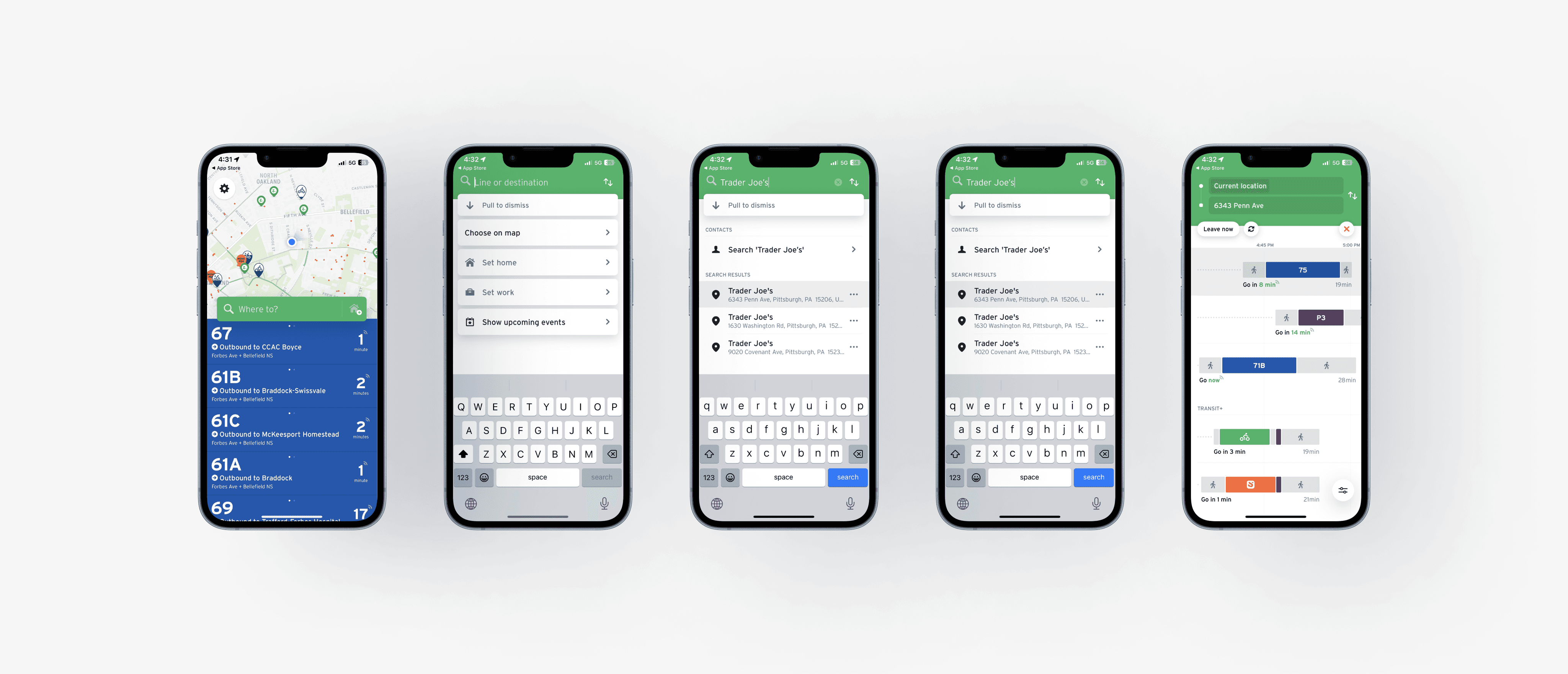


Current Transit UI
Redundant user inputs from app launch to navigation.
Transit does not recognize repetition in patterns.
User have a higher probability of being late by missing the best option.
When user is in a rush, friction points are amplified.
Painpoints
Painpoints
Redundant user inputs from app launch to navigation.
Transit does not recognize repetition in patterns.
User have a higher probability of being late by missing the best option.
When user is in a rush, friction points are amplified.
Redundant user inputs from app launch to navigation.
Transit does not recognize repetition in patterns.
User have a higher probability of being late by missing the best option.
When user is in a rush, friction points are amplified.
Redundant user inputs from app launch to navigation.
Transit does not recognize repetition in patterns.
User have a higher probability of being late by missing the best option.
When user is in a rush, friction points are amplified.
Painpoints
Painpoints
Solution
The proposed AUI streamlines the process into 3 interactions, reducing friction from 5 steps. It saves time by simplifying route comparison. Users are alerted to the best route. Early notifications help users avoid missing their commute and being late.
Proposed AUI
Proposed AUI
Proposed AUI
The proposed AUI streamlines the process into 3 interactions, reducing friction from 5 steps. It saves time by simplifying route comparison. Users are alerted to the best route. Early notifications help users avoid missing their commute and being late.
The proposed AUI streamlines the process into 3 interactions, reducing friction from 5 steps. It saves time by simplifying route comparison. Users are alerted to the best route. Early notifications help users avoid missing their commute and being late.
The proposed AUI streamlines the process into 3 interactions, reducing friction from 5 steps. It saves time by simplifying route comparison. Users are alerted to the best route. Early notifications help users avoid missing their commute and being late.
Proposed AUI
Solution
Solution
Solution
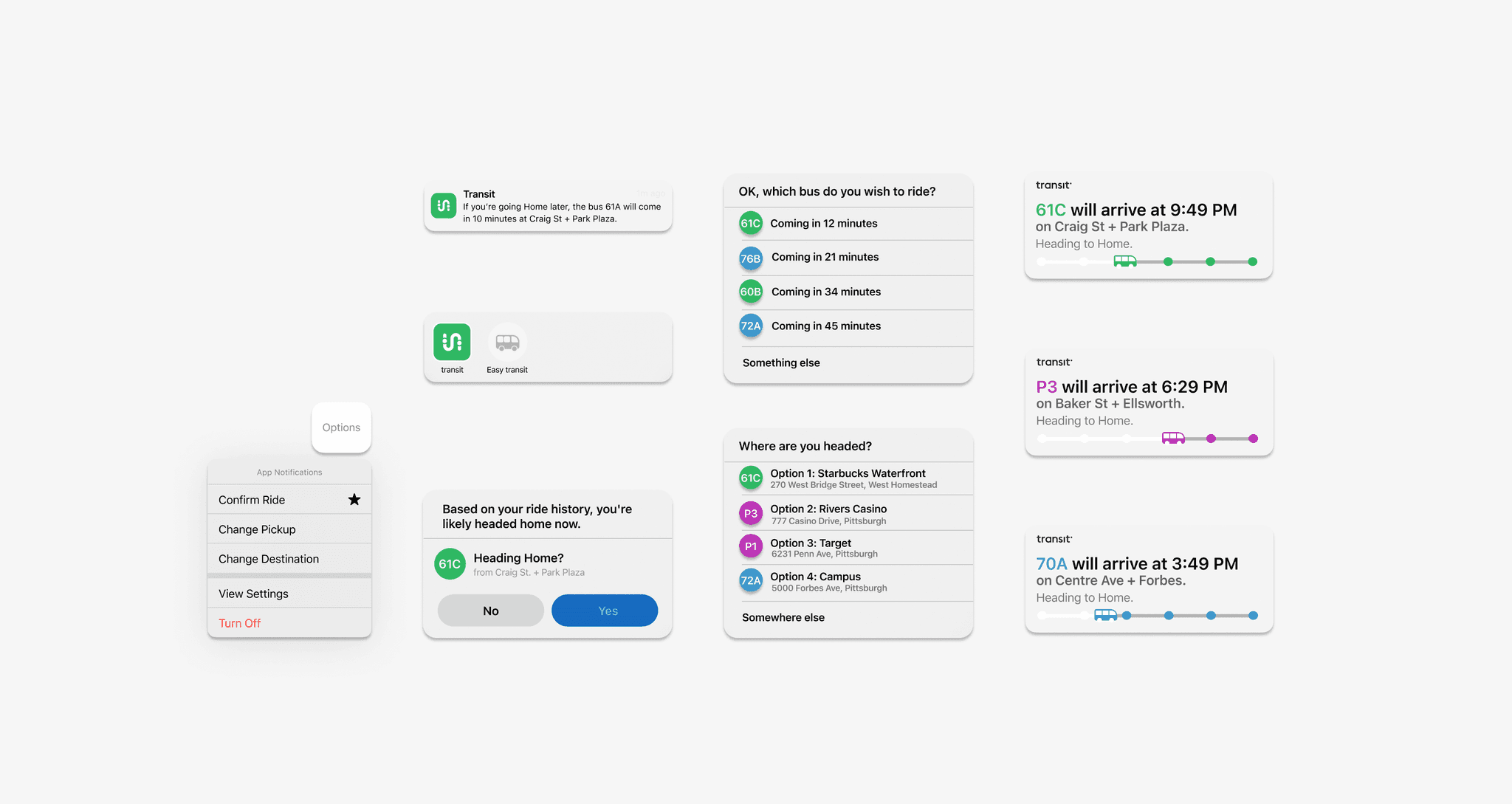


Augmented components based on suggested AUI
Notify the user before estimated arrival.
Prediction of potential destination and/or route.
Repair of inference errors when the prediction fails.
Suggestion of fastest transportation method.
What it aims to do
What it aims to do
Notify the user before estimated arrival.
Prediction of potential destination and/or route.
Repair of inference errors when the prediction fails.
Suggestion of fastest transportation method.
Notify the user before estimated arrival.
Prediction of potential destination and/or route.
Repair of inference errors when the prediction fails.
Suggestion of fastest transportation method.
Notify the user before estimated arrival.
Prediction of potential destination and/or route.
Repair of inference errors when the prediction fails.
Suggestion of fastest transportation method.
What it aims to do
What it aims to do
01
Notification based interactions
Notification based interactions
Transit will notify users based on travel patterns.
Notification based interactions
Notification based interactions
Transit will notify users based on travel patterns.
01
01
01
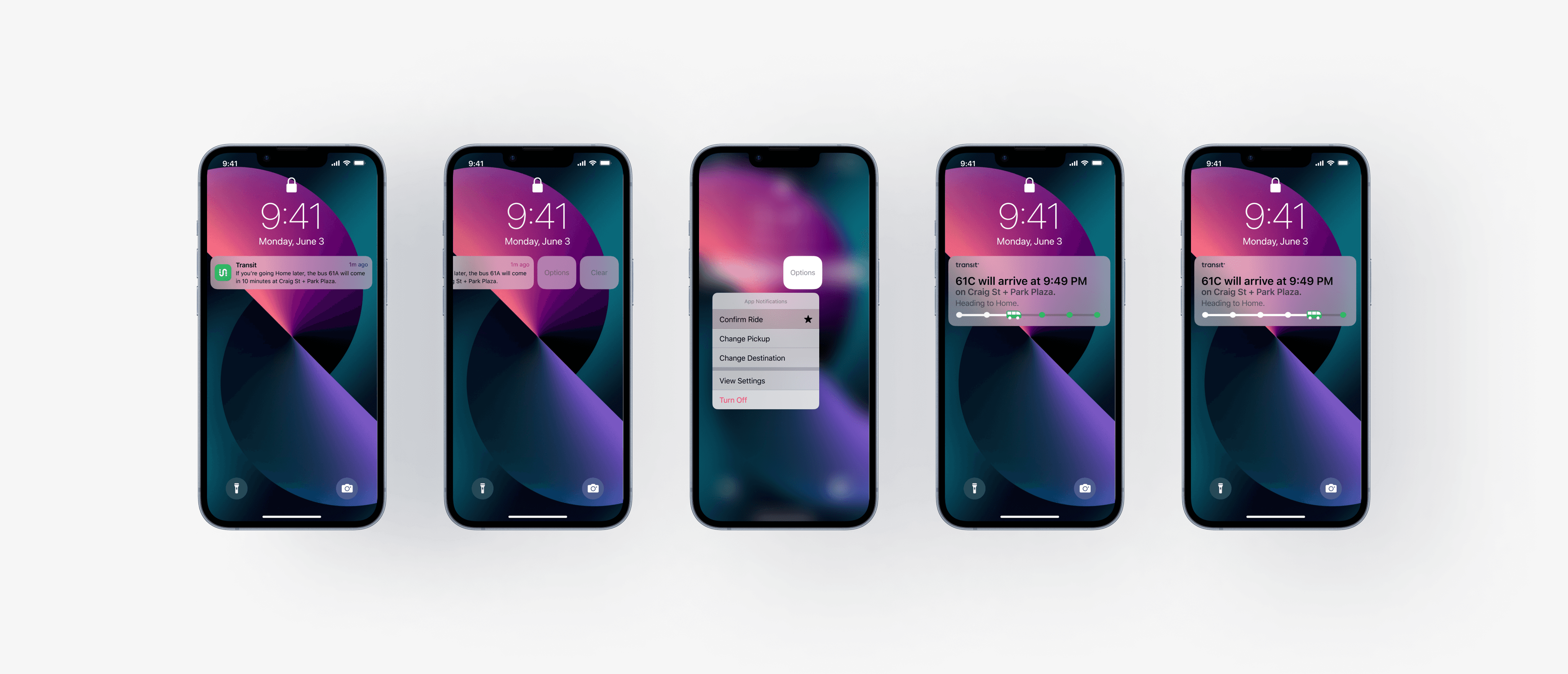


The AUI system will alert users based on their travel patterns, allowing them to check bus arrival times without unlocking their phones or accessing the Transit app.
02
Search / spotlight based interactions
Search / spotlight based interactions
On spotlight, Transit will recommend destinations.
Search / spotlight based interactions
On spotlight, Transit will recommend destinations.
02
02
02
On spotlight, Transit will recommend destinations.
Search / spotlight based interactions
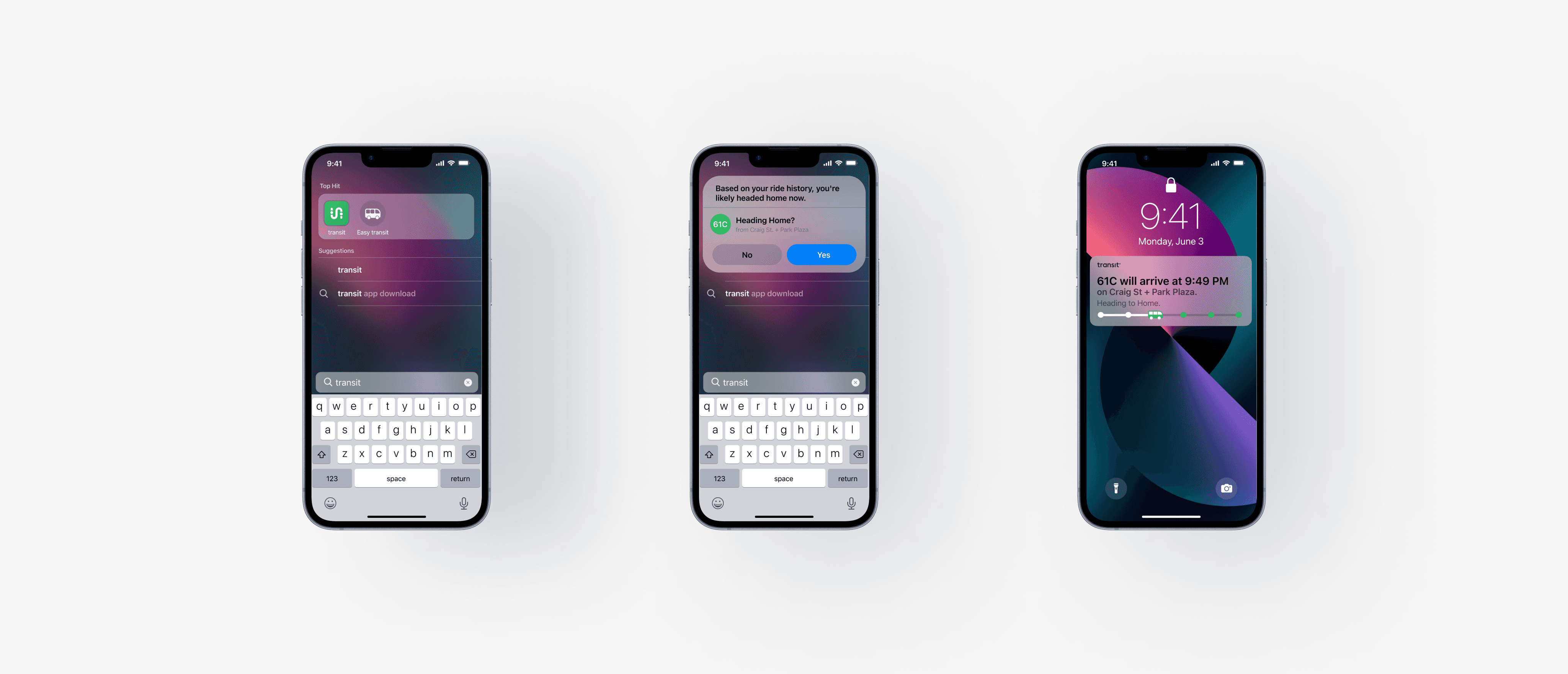


Implementing a "easy Transit" option to allow users quickly add bus information based on AUI detection of past destinations.
But what if it gets my predicted destination wrong?
But what if it gets my predicted destination wrong?
The AUI system will also offer anticipated destinations based on time and location, along with additional bus line details for each recommended destination.
The AUI system will also offer anticipated destinations based on time and location, along with additional bus line details for each recommended destination.
The AUI system will also offer anticipated destinations based on time and location, along with additional bus line details for each recommended destination.
The AUI system will also offer anticipated destinations based on time and location, along with additional bus line details for each recommended destination.
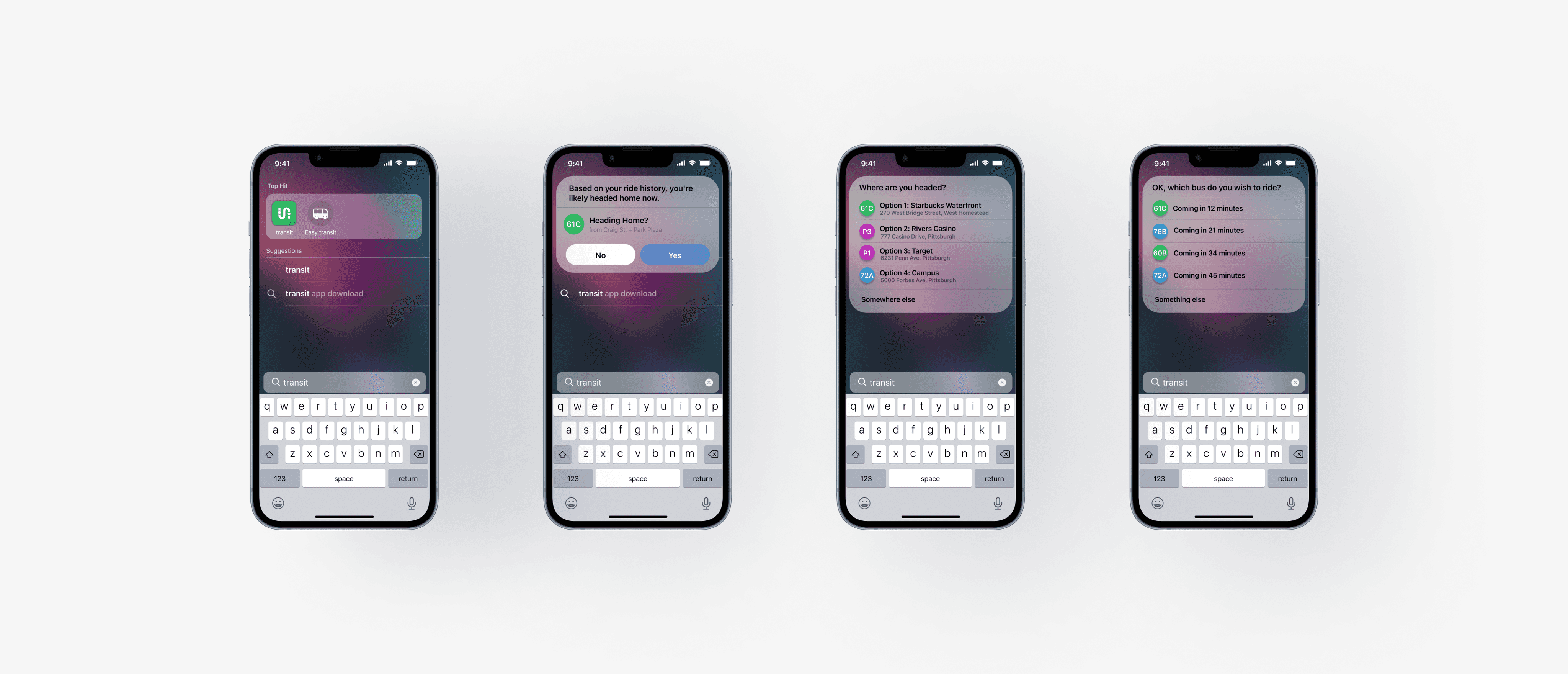


03
In-app options to add specific bus information
In-app options to add specific bus information
A streamlined approach for accessing precise bus information without constant app navigation.
In-app options to add specific bus information
A streamlined approach for accessing precise bus information without constant app navigation.
02
03
03
A streamlined approach for accessing precise bus information without constant app navigation.
In-app options to add specific bus information
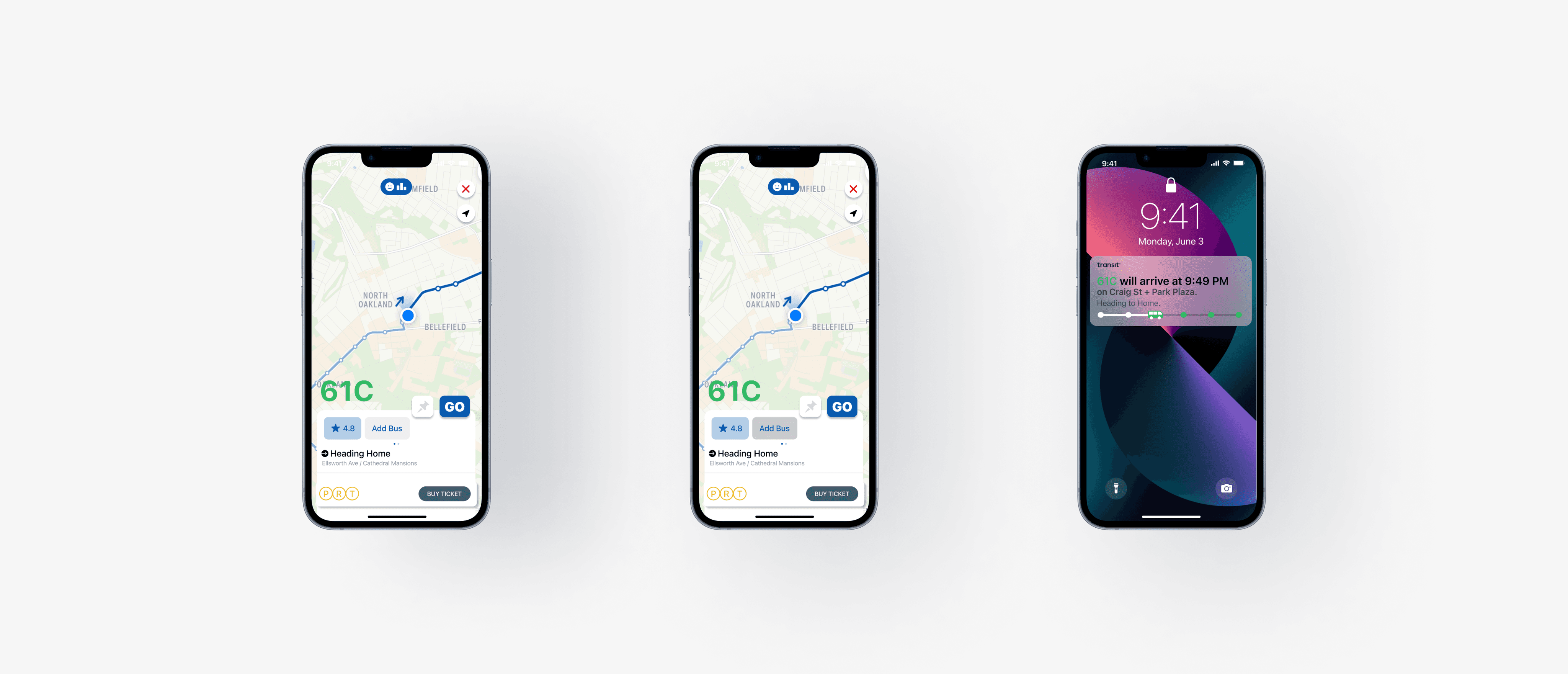


04
Implementation of visual queues
Implementation of visual queues
Users can promptly estimate the distance of a bus visually.
Implementation of visual queues
Users can promptly estimate the distance of a bus visually.
04
04
04
Users can promptly estimate the distance of a bus visually.
Implementation of visual queues



The visualization will adjust colors based on the bus line.
Profitability
Value Creation (user)
Value Creation (user)
Reduces friction in customer experience.
Increases user reliance on app for accuracy.
Saves valuable time for the app's users.
User is less likely to miss public transportation.
Value Creation (user)
Reduces friction in customer experience.
Increases user reliance on app for accuracy.
Saves valuable time for the app's users.
User is less likely to miss public transportation.
Profitability
Profitability
Profitability
Reduces friction in customer experience.
Increases user reliance on app for accuracy.
Saves valuable time for the app's users.
User is less likely to miss public transportation.
Value Creation (user)
Reduces friction in customer experience.
Increases user reliance on app for accuracy.
Saves valuable time for the app's users.
User is less likely to miss public transportation.
Revenue Creation (transit, partners)
Revenue Creation (transit, partners)
Increased user reliance on transit, leading to higher MAU and app usage frequency.
Improves user retention and subscription revenues for transit.
Increases in-app payments / revenues for partner agencies.
Potential to increase premium pricing in the long term with minimal impact on user volumes.
Revenue Creation (transit, partners)
Increased user reliance on transit, leading to higher MAU and app usage frequency.
Improves user retention and subscription revenues for transit.
Increases in-app payments / revenues for partner agencies.
Potential to increase premium pricing in the long term with minimal impact on user volumes.
Increased user reliance on transit, leading to higher MAU and app usage frequency.
Improves user retention and subscription revenues for transit.
Increases in-app payments / revenues for partner agencies.
Potential to increase premium pricing in the long term with minimal impact on user volumes.
Revenue Creation (transit, partners)
Increased user reliance on transit, leading to higher MAU and app usage frequency.
Improves user retention and subscription revenues for transit.
Increases in-app payments / revenues for partner agencies.
Potential to increase premium pricing in the long term with minimal impact on user volumes.
Return on investment
User Acceptance
User Acceptance
Reduces friction from 5 steps to 3.
Saves time spent comparing routes.
Alerts user to the best route to destination.
Helps user avoid missing their commute with an early notification.
User Acceptance
Reduces friction from 5 steps to 3.
Saves time spent comparing routes.
Alerts user to the best route to destination.
Helps user avoid missing their commute with an early notification.
Return on investment
Return on investment
Return on investment
Reduces friction from 5 steps to 3.
Saves time spent comparing routes.
Alerts user to the best route to destination.
Helps user avoid missing their commute with an early notification.
User Acceptance
Reduces friction from 5 steps to 3.
Saves time spent comparing routes.
Alerts user to the best route to destination.
Helps user avoid missing their commute with an early notification.
Financial Viability
Financial Viability
Increases app retention and repeat payments for transport agencies and Transit.
Financial Viability
Increases app retention and repeat payments for transport agencies and Transit.
Increases app retention and repeat payments for transport agencies and Transit.
Financial Viability
Increases app retention and repeat payments for transport agencies and Transit.
Technical Viability
Technical Viability
User travel history logs need to be stored, processed, and used to train the algorithm in order to provide adaptive predictions for users.
Sources of data include open APIs from transport agencies and real-time crowdsourced data.
Technical Viability
User travel history logs need to be stored, processed, and used to train the algorithm in order to provide adaptive predictions for users.
Sources of data include open APIs from transport agencies and real-time crowdsourced data.
User travel history logs need to be stored, processed, and used to train the algorithm in order to provide adaptive predictions for users.
Sources of data include open APIs from transport agencies and real-time crowdsourced data.
Technical Viability
User travel history logs need to be stored, processed, and used to train the algorithm in order to provide adaptive predictions for users.
Sources of data include open APIs from transport agencies and real-time crowdsourced data.
Heysu Oh
Last Updated : Nov 2024

